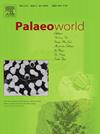Holocene palaeoenvironments of southern Sikhote-Alin Mountains (southern Far East), reconstructed from palaeontological data
IF 1.7
3区 地球科学
Q2 PALEONTOLOGY
引用次数: 0
Abstract
Due to the rarity of the archaeological cave sites in Primorsky Krai, the site known as “Perspektivnaya Cave” located in the southern part of the hard-to-reach areas of the the Sikhote-Alin mountain system north-north-east of Vladivostok, is of considerable interest. The first results of its study emphasise the importance of further research since human bones and ceramics were found there, as well as numerous mammal and bird bones, shells of terrestrial molluscs, and spores and pollen. These proxies can be utilised to contextualise the migration and presence of humans within an environmental framework. Palynological studies made it possible to reconstruct the landscapes and climatic conditions of the Early–Late Holocene when forest-steppe landscapes were widespread in the adjacent territory. Mesophilous herbs prevailed in open spaces, steppe plants and ferns on rocky slopes, mixed forests on the mountain slopes, and birch forests and swamps on river floodplains. Detailed studies have revealed the various fluctuations in the vegetation development described in the article. The warmest and most humid conditions were observed in the Middle Holocene, the optimal phase of the Holocene. A moderately warm and drier climate was characteristic of the Early and Late Holocene. The composition and structure of faunas from different periods of the Holocene corroborates the results of palynological studies. The Middle Holocene bird and mammal faunas are the most diverse in composition. The fossil molluscs lived under moderate climatic conditions in broadleaved forests growing near the cave, as well as in open spaces (forest edges or meadows) with well-developed herbaceous vegetation and in places of high humidity. Freshwater mollusc remains indicate that a river with a diverse range of near-water vegetation flowed near the cave.
远东南部锡霍特-阿林山脉南部全新世古环境的古生物重建
由于滨海边疆区考古洞穴遗址的稀罕性,这个被称为“Perspektivnaya洞穴”的遗址位于符拉迪沃斯托克东北北部的Sikhote-Alin山脉系统难以到达的南部地区,具有相当大的吸引力。该研究的初步结果强调了进一步研究的重要性,因为在那里发现了人骨和陶瓷,以及大量哺乳动物和鸟类的骨头,陆生软体动物的壳,以及孢子和花粉。这些代理可以用来在环境框架内将人类的迁移和存在置于背景中。孢粉学研究使得重建全新世早期-晚期的景观和气候条件成为可能,当时森林草原景观在邻近地区广泛分布。中温植物主要分布在开阔地带,草原植物和蕨类植物主要分布在岩石斜坡上,混交林主要分布在山坡上,白桦林和河流泛滥平原上的沼泽。详细的研究揭示了本文所描述的植被发育的各种波动。最温暖和最潮湿的环境出现在全新世中期,这是全新世的最佳时期。早、晚全新世的气候特征为偏暖偏干燥。全新世不同时期动物群的组成和结构证实了孢粉学研究的结果。中全新世的鸟类和哺乳动物在组成上最为多样化。这些软体动物化石生活在温和的气候条件下,生活在洞穴附近的阔叶林中,也生活在草本植物发达的开放空间(森林边缘或草地)和高湿度的地方。淡水软体动物遗骸表明,有一条河流在洞穴附近流动,河流中有各种各样的近水植被。
本文章由计算机程序翻译,如有差异,请以英文原文为准。
求助全文
约1分钟内获得全文
求助全文
来源期刊

Palaeoworld
PALEONTOLOGY-
CiteScore
4.00
自引率
5.90%
发文量
95
期刊介绍:
Palaeoworld is a peer-reviewed quarterly journal dedicated to the study of past life and its environment. We encourage submission of original manuscripts on all aspects of palaeontology and stratigraphy, comparisons of regional and global data in time and space, and results generated by interdisciplinary investigations in related fields. Some issues will be devoted entirely to a special theme whereas others will be composed of contributed articles. Palaeoworld is dedicated to serving a broad spectrum of geoscientists and palaeobiologists as well as serving as a resource for students in fields as diverse as palaeobiology, evolutionary biology, taxonomy and phylogeny, geobiology, historical geology, and palaeoenvironment.
Palaeoworld publishes original articles in the following areas:
•Phylogeny and taxonomic studies of all fossil groups
•Biostratigraphy, chemostratigraphy, chronostratigraphy
•Palaeoecology, palaeoenvironment and global changes throughout Earth history
•Tempo and mode of biological evolution
•Biological events in Earth history (e.g., extinctions, radiations)
•Ecosystem evolution
•Geobiology and molecular palaeobiology
•Palaeontological and stratigraphic methods
•Interdisciplinary studies focusing on fossils and strata
 求助内容:
求助内容: 应助结果提醒方式:
应助结果提醒方式:


